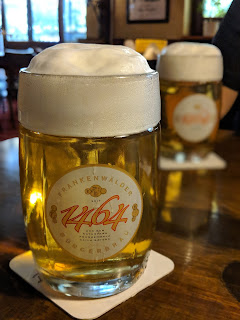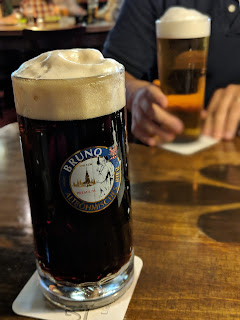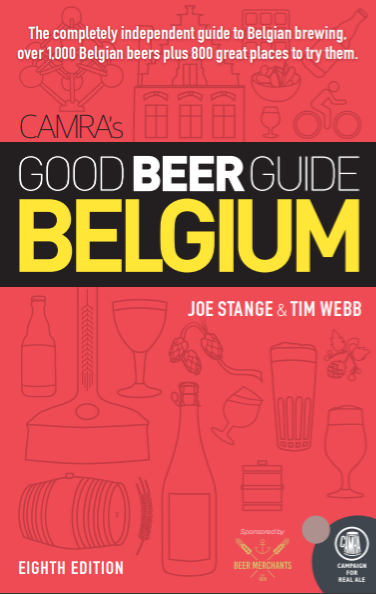How near to your home does a "local" need to be?
I don't live in one of the hipper parts of Berlin that are chock-a-block with bars. I live in a sleepy, green, leafy part of town where bars -- even smoky old Kiezkneipen* -- are far less common than retirement homes and samey, mediocre Italian restaurants. So I think anywhere within about 20 minutes' walk qualifies, to me, as a potential local. So what about a 20-minute bike ride, does that count?
I can walk to the excellent Foersters Feine Biere in about 20 minutes, and that makes me lucky. I call it my local. But at the moment it's closed for cleaning and repairs after some water damage in the summer. I wonder if the other regular punters in the neighborhood feel like I do... a bit rudderless without it. Even if I only pop in there once or twice a month, I like to know that I can.
There is another candidate not too far away: the Strassenbahn. It's been on my mind because I ride past it on the bus sometimes. A Kloster Andechs sign hangs out front, and that gets my attention. Eventually I remember to look the place up and see what it's about. Not long after, I invite a friend to meet me there, to finally go and have a look-see.
 It turns out I can bike there in eight minutes, whereas the walk would be a little less than half an hour. I'm going to activate the bicycle loophole here; it increases the radius of qualification. Strassenbahn is thus eligible as a backup local, in a pinch. By definition you can only have one real local, in my view. But maybe you can have alternates.
It turns out I can bike there in eight minutes, whereas the walk would be a little less than half an hour. I'm going to activate the bicycle loophole here; it increases the radius of qualification. Strassenbahn is thus eligible as a backup local, in a pinch. By definition you can only have one real local, in my view. But maybe you can have alternates.
The Strassenbahn's name means "streetcar." It sits just outside the Ring, halfway between the Bundesplatz and Heidelberger Platz stations. The busy bridges for S-Bahn trains and car traffic are visible from the pub's shady terrace, whose venerable trees nearly dominate the intersection.
Inside is plenty of dark wood, lampshades, old signage and photos -- strong signals of Gemütlichkeit.** A chalkboard overhead lists various dinner specials, all scratch cooking, most of it in the range of €5 to €8 per plate. Traditional North German things like herring share the menu with veggie moussaka or Thai curry soup. The main front barroom is non-smoking. I gather there is a smoking room somewhere, though I never notice it.
Unusually for a place like this, there are eight taps. The favored house pils is Franconian -- from Frankenwälder Burgerbräu in Naila -- so we start with that. It's the cheapest on the menu at €2.95 a half-liter, which suggests a concerted effort to have a beer of that size under €3. It implies some combination of nostalgia and general principle. (As you can see in the photos, the beers are also beautifully poured here.) The 1464 Pils itself is pretty fine; relatively thin for its region, moderately spicy-bitter, clean. For a Franconian pils it tastes a bit Northern. You could drink a lot of it without much arm-twisting.
 Next I go dark, to one listed on the menu as Bruno Schwarzbier. I've done my homework and already know it to be a tmavý ležák, one of those Czech-brewed dark lagers that tend to be richer and more malty than any German Schwarzbier. At 3.8% strength it is a 10-degree tmavý, which is pretty unusual in Czechia. In Germany it's legally a Schankbier. It tastes bigger: light caramelized sweetness, note of spicy licorice mingling with the roast. A lot of character but, again, very easy to drink. Later, when I think about going back to the Strassenbahn, this is the beer I think about most. That lush foam sticks in my memory too.
Next I go dark, to one listed on the menu as Bruno Schwarzbier. I've done my homework and already know it to be a tmavý ležák, one of those Czech-brewed dark lagers that tend to be richer and more malty than any German Schwarzbier. At 3.8% strength it is a 10-degree tmavý, which is pretty unusual in Czechia. In Germany it's legally a Schankbier. It tastes bigger: light caramelized sweetness, note of spicy licorice mingling with the roast. A lot of character but, again, very easy to drink. Later, when I think about going back to the Strassenbahn, this is the beer I think about most. That lush foam sticks in my memory too.
For my third and last beer I go with the one that drew my eyes here in the first place: Andechser Spezial Hell. At 5.8% strength this is no ordinary helles; it's a proper festbier. It's harvest time, you know? It pulls off that great Bavarian balancing act of sweet fulsome malt, gentle bitterness, and a finish just dry enough to keep you wanting more. Hey, some people think these beers are boring. I meet them sometimes, like this American working in Munich who says he doesn't like Bavarian beers, he only wants IPA. These people exist. I pity them.
There is another interesting thing about the Strassenbahn: It calls itself a Kneipenkollektiv -- a collectively owned pub. Six friends founded it a few weeks before I was born -- that is, a few weeks before Star Wars premiered. According to the website, they suspect that they are the oldest remaining collective in Berlin. Everybody who works there gets paid the same. Some proceeds go to charity.
No pricey pale ales here, no fruited IPAs, no selection of 100 bottled beers. Just a handful of well-brewed and perfectly poured lagers at fair prices. This is why I scratch my head when I visit Stone and see something like Mahrs U going for €6.50 per half-liter. Because it's robbery, that's why. There is no need to pay that much for a good lager if you're willing to look around town a bit, and visit some local institutions.
* Neighborhood bars, including Eckkneipen -- corner bars. Important Berlin institutions.
** Coziness.
Tuesday, October 2, 2018
Pubs of Berlin: The Strassenbahn.
Subscribe to:
Post Comments (Atom)






Excellent read again and vital learning. Cheers
ReplyDeleteCheers, Paul!
Delete